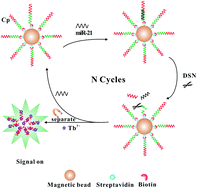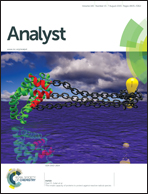Label-free microRNA detection based on terbium and duplex-specific nuclease assisted target recycling†
Abstract
In this paper, we describe a novel label-free fluorescence method for microRNA-21 (miR-21) detection based on terbium (Tb3+) and duplex-specific nuclease (DSN) assisted target recycling. Capture probes (Cps), containing a target-binding part and a signal-output part, are immobilized on magnetic beads (MBs). In the presence of the target miR-21, it hybridizes with the target-binding part of a Cp to form a DNA–RNA heteroduplex. Due to the considerable cleavage preference for DNA in DNA–RNA hybrids, DSN hydrolyzes the target-binding part of the Cp while liberating the intact target miR-21 to hybridize with a new Cp and initiate the second cycle of hydrolysis. Eventually, through magnetic separation, only the signal-output part of the Cp could remain in solution and function as a signalling flare to increase the fluorescence intensity of Tb3+ dramatically. By employing the above strategy, this approach can gain an amplified fluorescent signal and detect as low as 8 fM miR-21 under the optimized conditions. Moreover, due to the high selectivity of DSN, the method shows little cross-hybridization among the closely related miRNA family members even at the single-base-mismatched level. Successful attempts were made in applying the approach to detect miR-21 in human cell lysate samples of breast cancer patients.


 Please wait while we load your content...
Please wait while we load your content...